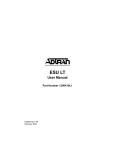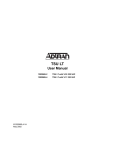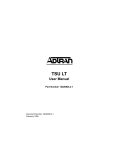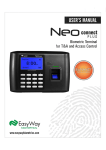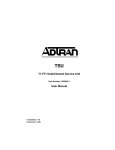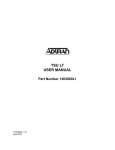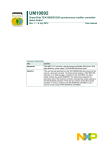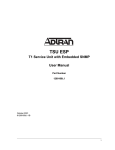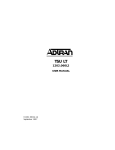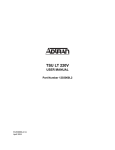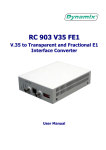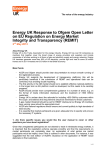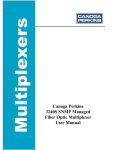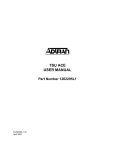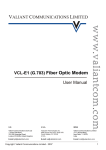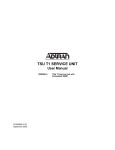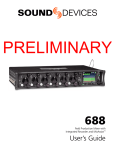Download ESU LT User Manual
Transcript
ESU LT User Manual Part Number 1200410L1 Document Number 61200410L1-1A June 1999 901 Explorer Boulevard P.O. Box 140000 Huntsville, AL 35814-4000 Phone: (256) 963-8000 © 1999 ADTRAN, Inc. All rights reserved. Printed in USA. ADTRAN Year 2000 (Y2K) Readiness Disclosure ADTRAN has established a Year 2000 program to ensure that our products will correctly function in the new millennium. ADTRAN warrants that all products meet Y2K specifications regardless of model or revision. Information about ADTRAN’s Y2K compliance program is available at the following locations: ADTRAN Web Site www.adtran.com Product Matrix www.adtran.com/y2kfax.html Faxback Document Line (256) 963-8200 Y2K plans and product certifications are listed in the matrix. Y2K Project Line (256) 963-2200 E-mail [email protected] iii Federal Communications Commission Radio Frequency Interference Statement: This equipment has been tested and found to comply with the limits for a Class B digital device, pursuant to Part 15 of the FCC Rules. These limits are designed to provide reasonable protection against harmful interference when the equipment is operated in a commercial environment. This equipment generates, uses, and can radiate radio frequency energy and, if not installed and used in accordance with the instruction manual, may cause harmful interference to radio frequencies. Operation of this equipment in a residential area is likely to cause harmful interference, in which case the user will be required to correct the interference at his own expense. Shielded cables must be used with this unit to ensure compliance with Class B FCC limits. Changes or modifications to this unit not expressly approved by the party responsible for compliance could void the user’s authority to operate the equipment. Canadian Class B Products The following information must be placed on the label and in the user’s manual for all Class B products shipped into Canada. This Class B digital apparatus meets all requirements of the Canadian Interference Equipment Regulations. Cet appareil numerique dela class B respecte les exigences du Reglement sur le Materiel Brouilleur du Canada. iv IMPORTANT SAFETY INSTRUCTIONS When using your telephone equipment, please follow these basic safety precautions to reduce the risk of fire, electrical shock, or personal injury: 1 Do not use this product near water, such as near a bath tub, wash bowl, kitchen sink, laundry tub, in a wet basement, or near a swimming pool. 2 Avoid using a telephone (other than a cordless-type) during an electrical storm. There is a remote risk of shock from lightning. 3 Do not use the telephone to report a gas leak in the vicinity of the leak. 4 Use only the power cord, power supply, and/or batteries indicated in the manual. Do not dispose of batteries in a fire. They may explode. Check with local codes for special disposal instructions. SAVE THESE INSTRUCTIONS v International Cordset Selection The following list is a selection of recommended cordset configurations to ensure protective earthing continuity when utilizing this product internationally. This list gives the proper rating, cordage type, and plug/connector configuration for the specific country where the product is to be utilized. Country Mimimum Cordage Type Rating 250 VAC, 10A HAR Plug Type CEE 7/7 Connector Type IEC 60320 C13 Australia, China Denmark India/South Africa Israel Italy Japan 250 VAC, 10A 250 VAC, 10A 250 VAC, 10A 250 VAC, 10A 250 VAC, 10A 125 VAC, 7 A AS 3112 Afsnit 107-2-D1 BS 546 SI-32 CEI-23-16/VII JIS 8303 IEC 60320 C13 IEC 60320 C13 IEC 60320 C13 IEC 60320 C13 IEC 60320 C13 IEC 60320 C13 Russian Federation Switzerland Ireland, United Kingdom Korea North America 250 VAC, 10A 250 VAC, 10A 250 VAC, 10A V76419 HAR HAR HAR HAR 12-1367 Yukita 300 V HAR HAR HAR GOST 7396 SEV 1011 BS 1363 IEC 60320 C13 IEC 60320 C13 IEC 60320 C13 125 VAC, 10A 125 VAC, 10A HAR AWG KSC 8305 NEMA 5-15 IEC 60320 C13 IEC 60320 C13 Austria Belgium Czech Republic Finland France Germany Greece Hungary Iceland Luxembourg Netherlands Norway Poland Portugal Slovenia Spain Sweden Yugoslavia vi Warranty and Customer Service ADTRAN will replace or repair this product within five years from the date of shipment if the product does not meet its published specifications or if it fails while in service. For detailed warranty, repair, and return information, see the ADTRAN Equipment Warranty and Repair and Return Policy Procedure. Return Material Authorization (RMA) is required prior to returning equipment to ADTRAN. For Service, RMA requests, or more information, contact one of the numbers found at the inside back page of this manual. vii viii Table of Contents List of Figures ............................................................................................................ xv List of Tables ...........................................................................................................xvii Chapter 1. Introduction ..........................................................................................1-1 ESU LT Overview .....................................................................................................1-1 Functional Description ......................................................................................1-1 ESU LT Rear Panel .............................................................................................1-2 ESU LT Features ................................................................................................1-3 ESU LT Interfaces ...............................................................................................1-3 Network Interface (NI) .............................................................................. 1-4 Network Test Interface .............................................................................. 1-4 Nx56/64 Serial Interface ........................................................................... 1-4 Control Port Input ......................................................................................1-4 Chain Port Output ..................................................................................... 1-4 Software Management.......................................................................................1-4 Front Panel ..................................................................................................1-4 T-Watch Pro Management Software Program ....................................... 1-5 ESU LT Testing ...................................................................................................1-5 Self-test ........................................................................................................1-5 Loopback Tests ...........................................................................................1-6 Network Loopbacks ........................................................................... 1-6 Payload Loopback .............................................................................. 1-6 DTE Interface Loopbacks ..........................................................................1-7 DTE Loopback ..................................................................................... 1-7 Pattern Generation .............................................................................................1-8 Bridge/Router Application .............................................................................. 1-9 Chapter 2. Installation ............................................................................................2-1 Inspecting for Shipping Damages ......................................................................... 2-1 Items Shipped by ADTRAN ............................................................................. 2-1 Items Provided by Customer............................................................................ 2-1 Power Connection..............................................................................................2-2 61200410L1-1 ESU LT User Manual ix Table of Contents Power Up Testing and Initialization ...............................................................2-2 Chapter 3. Operation...............................................................................................3-1 Operation ...................................................................................................................3-1 General Menu Operation ..................................................................................3-1 Menu Structure ...................................................................................................3-2 Four Opening Menu Functions ................................................................3-3 STATUS .......................................................................................................3-3 NI PERF RPTS (REPORTS) ................................................................3-3 CURR ERR/ALM ................................................................................3-3 ERR/ALM HIST ..................................................................................3-3 CONFIG .......................................................................................................3-3 NETWORK (NI) ..................................................................................3-3 UNIT .....................................................................................................3-3 PORT .....................................................................................................3-3 UTIL .............................................................................................................3-3 TIME/DATE ........................................................................................3-4 SOFTWARE REV ................................................................................3-4 REINIT UNIT .......................................................................................3-4 ADDRESS .............................................................................................3-4 SET PASSCODE ..................................................................................3-4 KEYPAD ...............................................................................................3-4 FACT RESTORE ..................................................................................3-4 TEST .............................................................................................................3-4 NETWORK TESTS ..............................................................................3-4 RUN SELF TEST ..................................................................................3-4 PORT TESTS ........................................................................................3-5 CANCEL TESTS ..................................................................................3-5 Menu Features ....................................................................................................3-5 Data Field ....................................................................................................3-5 Display Field ...............................................................................................3-5 Arrows .........................................................................................................3-5 Example Menu Operations .......................................................................3-5 To select a menu item... ......................................................................3-5 To select a submenu item ...................................................................3-6 To Set the Data Field ...........................................................................3-7 To View Display-Only Data Fields ...................................................3-7 To Exit Any Menu Field Operation or Display .............................. 3-7 Front Panel ..........................................................................................................3-8 Chapter 4. Status Menu ..........................................................................................4-1 STATUS ......................................................................................................................4-1 x ESU LT User Manual 61200410L1-1 Table of Contents NI PERF RPTS.....................................................................................................4-2 Reset Perf CNTRS ...............................................................................4-2 %AS .......................................................................................................4-2 %EF .......................................................................................................4-2 ES ...........................................................................................................4-2 BES ........................................................................................................4-2 SES .........................................................................................................4-3 DM ........................................................................................................4-3 UAS .......................................................................................................4-3 CURR ERR/ALM ...............................................................................................4-3 Alarms and Errors ......................................................................................4-4 LOSS OF SIGNAL ...............................................................................4-4 LOSS OF FRAME ................................................................................ 4-4 LOSS OF TS16 MF ...............................................................................4-4 LOSS OF CRC-4 .................................................................................. 4-4 AIS RECEIVED ....................................................................................4-4 TS16 AIS RCV ................................................................................... 4-4 REMOTE ALARM .............................................................................. 4-4 REMOTE MF ALARM ....................................................................... 4-4 EXT CLOCK ALARM ........................................................................4-4 BPV/CV RCVD ................................................................................... 4-4 FAS WORD ERROR ........................................................................... 4-5 E-BIT ERROR .......................................................................................4-5 PLL ALARM ........................................................................................4-5 ERR/ALM Hist...................................................................................................4-5 Chapter 5. Configuration Menu ........................................................................... 5-1 CONFIG .....................................................................................................................5-1 Network (NI) ......................................................................................................5-2 INTERFACE ................................................................................................5-2 FRAMING ...................................................................................................5-3 CCS ........................................................................................................5-3 CAS/TS16 ............................................................................................5-3 UNFRAMED ........................................................................................5-3 LINE CODE ...............................................................................................5-4 CRC-4 ...........................................................................................................5-4 NFAS WORD ..............................................................................................5-4 RFA GEN .....................................................................................................5-4 TIMING MODE ..........................................................................................5-4 Network Timing .................................................................................. 5-5 Internal Timing ................................................................................... 5-5 DTE Timing .........................................................................................5-6 61200410L1-1 ESU LT User Manual xi Table of Contents Unit .......................................................................................................................5-6 CNTRL PORT .............................................................................................5-7 POSITION ............................................................................................5-7 MODEM INIT ......................................................................................5-7 DATA RATE ........................................................................................5-7 ALARMS .....................................................................................................5-8 TRAPS ...................................................................................................5-8 OUTPUT ...............................................................................................5-8 TEL NUM .............................................................................................5-8 Port Config (Port Configuration) .....................................................................5-9 INTERFACE .........................................................................................5-9 TS0 RATE .............................................................................................5-9 MAPPING ............................................................................................5-9 DTE TX CLOCK ..................................................................................5-9 START TS0 .........................................................................................5-10 NUMBER OF TS0s ............................................................................5-10 DATA ..................................................................................................5-10 CTS ......................................................................................................5-10 DCD ....................................................................................................5-10 DSR ......................................................................................................5-10 INBAND .............................................................................................5-11 Chapter 6. Utility Menu..........................................................................................6-1 UTIL ............................................................................................................................6-1 Time/Date ...........................................................................................................6-2 Software Rev ......................................................................................................6-3 Reinit Unit ...........................................................................................................6-3 Address ................................................................................................................6-3 Set Passcode ........................................................................................................6-3 Keypad .................................................................................................................6-4 Fact Restore .........................................................................................................6-4 Chapter 7. Test Menu..............................................................................................7-1 TEST ............................................................................................................................7-1 Network Tests .....................................................................................................7-2 LOCAL LOOPBCK ....................................................................................7-2 No Loopback ........................................................................................7-2 Line On .................................................................................................7-2 Payload On ...........................................................................................7-2 REMOTE LOOPBCK .................................................................................7-3 No Loopback ........................................................................................7-3 FE1 Loopback ......................................................................................7-3 xii ESU LT User Manual 61200410L1-1 Table of Contents TEST PATTERN .........................................................................................7-3 1:8 ALL TS0s ........................................................................................7-3 QRSS ACT TS0s ................................................................................... 7-3 511 Active TS0s ................................................................................... 7-3 All Zeros ...............................................................................................7-3 All Ones ................................................................................................7-3 CLR ERRORS ..............................................................................................7-4 INSERT QRSS or 511 ERRORS ................................................................. 7-4 Run Self-test ........................................................................................................7-5 Port Tests .............................................................................................................7-6 Cancel Tests.........................................................................................................7-6 Chapter 8. Example Operations ............................................................................ 8-1 Testing Examples ......................................................................................................8-1 Far End Looped Back Test ................................................................................ 8-1 Network Interface Test ......................................................................................8-1 Appendix A. ESU LT Menu Tree ....................................................................... A-1 Appendix B. DTE Data Rate Chart ..................................................................... B-1 Appendix C. Pinouts............................................................................................. C-1 Index ..................................................................................................................Index-1 61200410L1-1 ESU LT User Manual xiii Table of Contents xiv ESU LT User Manual 61200410L1-1 List of Figures Figure 1-1. ESU LT Unit - Front View .................................................................... 1-1 Figure 1-2. ESU LT Rear Panel ................................................................................ 1-2 Figure 1-3. ESU LT Interfaces.................................................................................. 1-3 Figure 1-4. Network Loopback Tests ..................................................................... 1-6 Figure 1-5. DTE Interface Loopback ...................................................................... 1-7 Figure 1-6. Simple Bridge Application on a E1 or FE1 Circuit........................... 1-9 Figure 3-1. ESU LT Main Menu .............................................................................. 3-1 Figure 3-2. ESU LT Main Menu Screen.................................................................. 3-2 Figure 3-3. Cursor on Menu Item........................................................................... 3-6 Figure 3-4. Submenu Fields..................................................................................... 3-6 Figure 3-5. Front Panel Layout ...............................................................................3-8 Figure 4-1. Status Menu..........................................................................................4-1 Figure 4-2. Severely Errored Seconds Scree ........................................................ 4-2 Figure 4-3. Loss of Signal (Current Errors/Alarms) Screens ............................. 4-3 Figure 4-4. Clear History Screen............................................................................. 4-5 Figure 5-1. Configuration Menu............................................................................. 5-1 Figure 5-2. Network Submenu ...............................................................................5-2 Figure 5-3. Network Timed Clock Source ............................................................. 5-5 Figure 5-4. Internal Timing Clock Source ............................................................. 5-5 Figure 5-5. DTE Clock Source ................................................................................. 5-6 Figure 5-6. Configuration Submenu ...................................................................... 5-6 Figure 5-7. Inband Remote Configuration...........................................................5-11 Figure 6-1. Utility Menu ..........................................................................................6-1 Figure 6-2. Time/Date Screen ................................................................................. 6-2 Figure 6-3. Address Screen......................................................................................6-3 Figure 7-1. Test Menu...............................................................................................7-1 Figure 7-2. Local Loopback Screen......................................................................... 7-2 61200410L1-1 ESU LT User Manual xv List of Figures Figure 7-3. Clear Errors Screen ...............................................................................7-4 Figure 7-4. Self Test Results Screen.........................................................................7-5 Figure 7-5. Loopback Setting Screen ......................................................................7-6 Figure 8-1. Main Menu with TEST Selected .........................................................8-2 Figure 8-2. Test Menu with NETWORK TESTS Selected.................................... 8-2 Figure 8-3. Local Loopback Test Menu ..................................................................8-3 Figure 8-4. Remote Loopback Test Menu ..............................................................8-3 Figure 8-5. Test Pattern Scree ................................................................................8-4 Figure 8-6. Clear Errors Screen ...............................................................................8-5 Figure A-1. ESU LT Menu Tree (Status and Config)...........................................A-1 Figure A-2. ESU LT Menu Tree (Util and Test) ....................................................A-2 xvi ESU LT User Manual 61200410L1-1 List of Tables Table 5-1. Normal Mode Operation for Port Control Signals......................... 5-11 Table 6-1. Editing the Time/Date ..........................................................................6-2 Table B-1. DTE Data Rate vs. TS0s.........................................................................B-1 Table C-1. Network Pinouts................................................................................... C-1 Table C-2. Control-In/Chain-In Pin Assignments ............................................. C-2 Table C-3. Chain-Out Pin Assignments ............................................................... C-3 Table C-4. Nx56/64 Pin Assignments for EIA-530 and V.36 ............................ C-4 Table C-5. Nx56/64 Pin Assignments for V.35 Mode ........................................ C-5 Table C-6. Adapter Cable, DB 25 to V.35, 34-Pin Winchester ........................... C-6 Table C-7. Nx56/64 Pin Assignments for V.11/x.21 Mode .............................. C-7 Table C-8. Adapter Cable DB25 to X.21, DB15 Connector ................................ C-8 61200410L1-1 ESU LT User Manual xvii List of Tables xviii ESU LT User Manual 61200410L1-1 Introduction Chapter 1 ESU LT OVERVIEW This section provides a functional description of the ESU LT, describes its features, and illustrates its four interfaces. Functional Description The ADTRAN ESU LT is one of several E1 CSU/DSUs that offer complete flexibility for connection of various data sources to E1 or FE1 facilities. This family of ESU products includes the following: • ESU LT - E1 CSU/DSUs with a single Nx56K/64K serial port. • ESU 120e - Same as the ESU LT with the added feature of a G.703 Drop port and a slot in the rear panel to house a option module. Each module offers up to four additiona data ports. ENTER TEST ALM ERR PWR CANCEL ESU LT TD RD RS CS Figure 1-1. ESU LT Unit - Front View 61200410L1-1 ESU LT User Manual 1-1 Chapter 1. Introduction The ESU LT serves as the link between user data sources such as local area network (LAN) bridges and routers, computers, CAD systems, and teleconferencing equipment. The amount of bandwidth allocated to the port is user-programmable. The data terminal equipment (DTE) data can occupy contiguous or alternate channels in the E1 stream, and the channels may start at any position. ESU LT Rear Panel Number Identification for ESU LT Rear Panel No. Item Function 1 Network E1-FE1 network interface 2 MON (Monitor) Bantam test jack 3 Chain-In Interface of chain-in 4 Chain-Out Connects to chain-in of another ESU LT 5 Nx56/64 DTE port 6 Power Switch Used to turn power on or off 7 Power Cord Connector IEC connector for power cord 1 2 3 4 5 6 7 CONTROL NETWORK MON CHAIN IN CHAIN OUT NX 56/64 90-240 VAC 50/60 HZ.24A Figure 1-2. ESU LT Rear Panel 1-2 ESU LT User Manual 61200410L1-1 Chapter 1. Introduction ESU LT Features • An E1 interface and an Nx56/64 DTE serial interface port. • Easy configuration capabilities using simplistic menus displayed in a liquid crystal display (LCD) window operated by a front panel keypad. • Data port supports V.35, EIA-530, V.36 and X.21 electrical interfaces. • Selectable timing from the network, the Nx56/64 DTE port, or internally. • All ones, all zeros, 511, QRSS, and 1:8 test patterns. • Extensive self-testing and monitoring ensures proper operation. • Flexible channel allocation (any starting channel and alternate or contiguous). ESU LT Interfaces The ESU LT is equipped with four interfaces: • E1 Network interface per ITU G.703 • Nx56/64 high-speed, multiprotocol serial interface • Control input (EIA-232)/Chain port input • Chain port output See Figure 1-3 and the following descriptions in this section. ESU LT ESU LT Figure 1-3. ESU LT Interfaces 61200410L1-1 ESU LT User Manual 1-3 Chapter 1. Introduction Network Interface (NI) The Network Interface (NI) port provides the connection to the E1. This port complies with the applicable ANSI and CCITT standards. Either the 120Ω DB15 or the 75Ω BNC interface (adapter provided) may be used for the Network Interface. The 75/120 selection must be made with the front panel menus. For more information, see Wiring on page C-1. Network Test Interface The MON test jack provides a bridges access jack for nonintrusive monitoring of the incoming E1. Nx56/64 Serial Interface The Nx56/64 provides a serial interface that operates from 56kbps to 2.048 Mbps. The Nx56/64 can be configured as a V.35,V.36, EIA-530, or V.11 electrical interface through the front panel menus. Control Port Input The control port input provides an EIA 232 input from a PC or a modem for control of the ESU LT. You can also use it as a chain input from another ESU LT or ESU 120e. For more information, see Wiring on page C-1. Chain Port Output The chain port output provides an EIA-232 output to chain control to other ESU LTs or ESU 120es. For more information, see Wiring on page C-1. Software Management Front Panel The front panel provides complete and easy control of all items that can be configured through menu-guided options. The front panel LCD also displays the status of operation and performance reports for the unit. A complete discussion of the operation of the front panel is found in Chapter 3, Operation on page 3-1. The menu options are found in Chapters 4 through 7. 1-4 ESU LT User Manual 61200410L1-1 Chapter 1. Introduction T-Watch Pro Management Software Program T-Watch Pro is the ADTRAN management software program that allows the user to control the ESU LT from a PC. It provides complete control over the configuration of the ESU LT using a graphic interface. The T-Watch Pro program displays the same status and performance data as the front panel LCD. This data is displayed as tables and graphs. The T-Watch Pro program has the following capabilities: • Interfaces with a modem which permits dialing into a remote ESU LT location to configure the unit or read the unit’s status or performance. • The performance data read from the units can be exported in a file which is compatible with common spread sheet programs. ESU LT Testing The ESU LT offers three forms of testing: • Self-test • Loopback tests • Pattern generation and check Self-test The self-test checks the integrity of the internal operation of the electronic components by performing memory tests and by sending and verifying data test patterns through all internal interfaces. Although actual user data cannot be passed during these tests, the self-test can run with the network and DTE interfaces in place, without disturbing any external interface. The self-test automatically executes upon power up. It can also be commanded from a front panel menu or from the control port. In addition to the specified self-tests, background tests are also run on various parts of the internal electronics. These 61200410L1-1 ESU LT User Manual 1-5 Chapter 1. Introduction run during normal operation to confirm continued correct functioning. The background tests include: • Monitoring the phase-locked loop for lock. • Standard background network performance monitoring. Loopback Tests A number of different loopbacks can be invoked locally from the front panel, by T-Watch commands, or remotely using V.54 loopback code. Network Loopbacks There are two types of network loopbacks. See Figure 1-4. Payload Loopback Similar to line loopback, except that the framing is extracted from the received data and then regenerated for the transmitted data. Line Loopback Loops all of the received data back toward the network. The transmitted data is the identical line code that was received, including any bipolar violations or framing errors. ESU E1 Figure 1-4. Network Loopback Tests 1-6 ESU LT User Manual 61200410L1-1 Chapter 1. Introduction DTE Interface Loopback The Nx56K/64K serial interface offers a DTE loopback. See Figure 1-5. DTE Loopback Loops all data from the DTE back towards the DTE. This loopback may be initiated by using the front panel or T-Watch commands. The DTE (or the external test equipment) must provide a test pattern to check the DTE interface. ESU Figure 1-5. DTE Interface Loopback 61200410L1-1 ESU LT User Manual 1-7 Chapter 1. Introduction Pattern Generation The ESU LT offers five test patterns: 511, QRSS, 1:8, All Ones, and All Zeros. 511 The 511 pattern is generated and checked by the Nx56K/ 64K serial interface. It only appears in the TS0s assigned to the Nx56K/64K port. When used in conjunction with the payload loopback at the far end, an end-to-end integrity check can be made on the DTE ports. QRSS The ESU LT has an internal QRSS pattern generator and detector. The pattern appears only in the TS0s assigned to the Nx56K/64K port. The QRSS test pattern can be used in conjunction with network loopbacks to perform end-toend tests. 1:8 The 1:8 is a stress pattern which places the maximum number of 0s in the transmitted data. This is always done over all time slots. This pattern is used in conjunction with external test equipment to determine if the E1 line is performing acceptably under a stress condition. Each channel of the E1 has only one bit set. All Zeros Generates an all zeros pattern in every channel. All Ones 1-8 Generates an all ones pattern in every channel. ESU LT User Manual 61200410L1-1 Chapter 1. Introduction Bridge/Router Application A bridge or router can be interfaced to the network by using the DTE interface. The bandwidth used is programmable at Nx56 or Nx64 data rates for E1 or FE1 service. The bandwidth can be selected as contiguous or alternate. Figure 1-6 shows a simple bridge application. Bridge Router Nx56/64 High-speed serial interface ESU LT ESU LT E1 Nx56/64 Bridge Router High-speed serial interface Figure 1-6. Simple Bridge Application on a E1 or FE1 Circuit 61200410L1-1 ESU LT User Manual 1-9 Chapter 1. Introduction 1-10 ESU LT User Manual 61200410L1-1 Installation Chapter 2 INSPECTING FOR SHIPPING DAMAGES Carefully inspect the ESU LT for any shipping damage. If damage is suspected, file a claim immediately with the carrier and then contact ADTRAN Customer Service. If possible, keep the original shipping container for use in shipping the ESU LT back for repair or for verification of damage during shipment. Items Shipped by ADTRAN The following items are included in the ADTRAN shipment: • ESU LT unit • DB-15 to BNC adapter • ESU LT User Manual • DB-15 to solid conductor cable Items Provided by Customer • 61200410L1-1 DTE cable(s) • Cable for supervisory port, if used • Power cable • Cable for connection to either the 120Ω DB-15 or 75Ω BNC network interface ESU LT User Manual 2-1 Chapter 2. Installation Power Connection Power is supplied to the ESU LT through an IEC-type power connector on the rear of the unit. Power to the ESU LT must be from a grounded 90-240 VAC, 50/60 Hz power source. Power Up Testing and Initialization When shipped from the factory, the ESU LT is set to factory default conditions. At the first application of power, the unit automatically executes self-tests followed by an initializatio sequence which sets up the unit. The following chart explains how Self-tests work. When Then A power-up or commanded self-test occurs The LCD displays ADTRAN ESU LT INITIALIZING and the LEDs illuminate sequentially. The self-test is comThe LCD momentarily displays ALL TESTS pleted with no failures PASSED. detected A failure is detected 2-2 It is displayed in the LCD window. The automatic self-test consists of the following tests: Board level tests Random access memory (RAM) tests; erasable programmable read only memory (EPROM) checksum. On-board data path. Sending a known test pattern through an on-board loop. Unit level tests Front panel LED verification. Phase lock loop verify. ESU LT User Manual 61200410L1-1 Operation Chapter 3 OPERATION The ESU LT can be configured and controlled from either the local front panel or from a PC using the T-Watch Management Software Program. General Menu Operation The ESU LT uses a multilevel menu structure containing both menu items and data fields. All menu operations and data are displayed in the LCD window. The menu items are numbered and can be viewed by using the Up and Down arrows. 1) NI PERF RPTS 1) STATUS 2) CURR ERR/ALM 3) ERR/ALM HIST 1) NETWORK (NI) MAIN MENU 2) CONFIG 2) UNIT 3) PORT 1) TIME/DAY 3) UTIL 2) SOFTWARE REV 3) REINIT UNIT 4) TEST 1) NETWORK TESTS 4) ADDRESS 2) RUN SELFTEST 5) SET PASSCODE 3) PORT TESTS 6) KEYPAD 4) CANCEL TESTS 7) FACT RESTORE Figure 3-1. ESU LT Main Menu 61200410L1-1 ESU LT User Manual 3-1 Chapter 3. Operation Menu flow is normally depicted from left to right. Arrows on the lower right of the screen indicate the direction of additional menu items. At every level of the menu, pressing Cancel returns the system to the previous menu level. Pressing Cancel repeatedly returns the system to the main menu. The opening menu is the access point to all other operations. There are four main menu items, 1)STATUS, 2)C ONFIG, 3)UTIL, 4)TEST. Each Main Menu item has several functions and submenus to identify and access specific parameters. Eac main item menu contains a complete menu diagram to identify the location of each operation. Menu Structure The ESU LT uses hierarchical menus to access its many features. The main menu level (Figure 3-2) leads to submenus (see Figure 3-1 on page 3-1). All menu operations are displayed in the LCD window. The complete ESU LT menu diagram is shown in ESU LT MenuTree (Status and Config) on page A-1 and ESU LT Menu Tree (Util and Test) on page A-2. Figure 3-2. ESU LT Main Menu Screen This menu structure diagram is a limited overview. A brief description of each menu item, presented in menu order, immediately follows. A complete menu diagram is shown in ESU LT Menu Tree (Status and Config) on page A-1 and ESU LT Menu Tree (Util and Test) on page A-2. 3-2 ESU LT User Manual 61200410L1-1 Chapter 3. Operation Four Opening Menu Functions STATUS The S TATUS MENU provides the ability to view the status of the ESU LT operation. This menu includes the followin items: NI PERF RPTS (REPORTS) Used to display the user’s copy of the Network Interface performance reports. The ESU LT maintains this performance data based on G.821. Data that is displayed is based on performance over the last 15 minute interval and over the last 24 hours. CURR ERR/ALM Used to view current errors/alarms which are being reported by the ESU LT. ERR/ALM HIST Used to view and clear history errors and alarms. CONFIG The CONFIGURATION MENU is used to set the ESU LT operational configuration. This menu includes the following sub-items. NETWORK (NI) Used to set all of the parameters associated with the network interface. UNIT Used to control ESU LT control port baud rate and to set up the dial out function. PORT Used to configure the parameters associated with the highspeed serial interface port. UTIL The UTILITY M ENU is used to view and to set system parameters. This menu includes the following sub-items: 61200410L1-1 ESU LT User Manual 3-3 Chapter 3. Operation TIME/DATE Accesses the display and allows the setting of the current time and date. SOFTWARE REV Displays the version number of the current software revision level. This information is required when requesting assistance from ADTRAN Customer Service or when updates are needed. REINIT UNIT Used to reinitialize the unit. This menu item is not used to restore the factory default settings for all parameters. ADDRESS Used to view and change the current Unit Address used for control port access. SET PASSCODE Allows a passcode to be set. KEYPAD Used to lock the front panel keypad. With the keypad locked, the unit’s configuration can be viewed but not changed. FACT RESTORE Restores factory default settings for all unit parameters. TEST The TEST MENU is used to initiate different types of tests of the unit and to view test results. Test results are displayed in the LCD window. The menu contains three sub-items. Test execution disrupts some normal operations. See individual menu items concerning tests before executing. NETWORK TESTS Control the activation of loopbacks and the initiation of data test patterns. RUN SELF TEST Used to execute an internal self-test. 3-4 ESU LT User Manual 61200410L1-1 Chapter 3. Operation PORT TESTS Used for the testing of the DTE port. CANCEL TESTS Deactivates all active tests, including those on option modules. Menu Features Data Field A menu item followed by a colon (:) identifies an editable data field. Display Field A menu field followed by alarm or error information. Arrows Menus that display small Up or Down Arrows in the lower right corner indicate there are more menu items than are viewable on a two-line LCD. The additional menu items are accessed with the Up or Down Arrows. (Undisplayed menu items are also available by using the appropriate menu number.) Example Menu Operations To select a menu item... Step Action 1 Use the Up and Down arrows to place the cursor on the desired menu item (in this example CONFIG). See Figure 3-3. 2 Place the cursor on the number 2 and press Enter. The unit responds by displaying the first two available submenu fields. The cursor is on the first field. If there are mor than two menu fields, a Down arrow is visible on the lower right corner. See Figure 3-4. 61200410L1-1 ESU LT User Manual 3-5 Chapter 3. Operation Figure 3-3. Cursor on Menu Item Figure 3-4. Submenu Fields To select a submenu item Step Action 1 Use the same operation used to select an opening menu item. 2 Use the Up and Down Arrows to place the cursor on the desired menu item. In this example, NETWORK (NI). The unit responds by displaying the first two available data field items. The cursor is on the number of the first item. When there are more than two data field items for the selected submenu, a Down Arrow is visible on the lower right corner. 3-6 ESU LT User Manual 61200410L1-1 Chapter 3. Operation To Set the Data Field Data fields that are available for editing are preceded by a colon (:). Step 1 Action Press Enter while the cursor is located on the submenu item number. The cursor moves to the data field, to the right of the submenu item name. You can use the Up and Down Arrows to scan the available value settings which display in the data field position, one at a time. 2 When the desired value is in the data field position, press Enter to set the value. The unit is set for the value shown in the data field and the cursor moves back to the submenu item position indicating the operation is complete.You can select another submenu field or press Cancel to return to the submenu. Cancel is available any time during the operation. If used prior to pressing Enter after making a data change, the original data value is restored and the cursor returns to the submenu field. To View Display-Only Data Fields An example of a DISPLAY ONLY data field is found by selecting the following menu choices: Step 1 2 Action Select STATUS from the MAIN MENU. Select submenu CURR ERR/ALM. LOSS OF SIGNAL INACTIVE/ACTIVE is displayed, giv- ing the current state of the alarm. To Exit Any Menu Field Operation or Display Press Cancel as many times as required to return to the desired menu level. 61200410L1-1 ESU LT User Manual 3-7 Chapter 3. Operation Front Panel The ESU LT front panel is shown in Figure 3-5. Unit features are identified by call-outs. 10 1 2 3 4 PWR ERR ALM TEST TD RD RS CS 5 6 12 ENTER CANCEL ESU LT 9 11 13 7 8 Figure 3-5. Front Panel Layout Item Displays Function 1 PWR LED ON when power is received by ESU LT. 2 ERR LED ON when errors such as BPV, CRC-4, FAS word or E-bit errors have occurred in the last second. 3 ALM LED ON when an alarm condition exists. 4 TEST LED ON when unit is in test mode. 5 TD LED ON when DTE data is being transmitted. 6 RD LED ON when DTE data is being received. 7 RS LED ON when request to send (RTS) active from DTE. 8 CS LED ON when ESU LT has clear to send (CTS) active toward DTE. 9 LCD A 2X16 LCD window that displays menu items used in configuration and displays information useful in monitoring the unit. Operation Keys: 10 & 11 3-8 Up/Down Keyboard arrows used to travel up/down menu trees. Arrows increase/decrease numeric values and scroll through selections. 12 Enter Used to choose paths and make selections. 13 Cancel Used to exit selections or menu tree branches. ESU LT User Manual 61200410L1-1 Status Menu Chapter 4 STATUS The STATUS MENU branch provides the ability to view the status of the ESU LT operation. See Figure 4-1. RESET PERF CNTRS %AS %EF 1) NI PERF RPTS ES BES SES LOSS OF SIGNAL DM LOSS OF FRAME UAS LOSS OF TS16 MF 2) CURR ERR/AL LOSS OF CRC-4 1)STATUS AIS RECEIVED 3) ERR/ALM HIST CLEAR HISTORY TS16 AIS RCVD LOSS OF SIGNAL REMOTE ALARM LOSS OF FRAME REMOTE MF ALARM LOSS OF TS16 MF EXT CLOCK ALARM LOSS OF CRC-4 BPV/CV RCVD OUT OF FRAME FAS WORD ERROR AIS RECEIVED E-BIT ERROR TS16 AIS RCVD PLL ALARM REMOTE ALARM REMOTE MF ALARM EXT CLOCK ALARM BPV/CV RCVD FAS WORD ERROR E-BIT ERROR PLL ALARM Figure 4-1. Status Menu 61200410L1-1 ESU LT User Manual 4-1 Chapter 4. Status Menu NI PERF RPTS The Network Interface Performance Reports display the user’s copy of the performance data. The ESU LT maintains this performance data on the network based on G.821. The data displayed is data accumulated over the last 15 minutes and over the last 24 hours. These fields cannot be edited, only cleared as previously discussed. Only the user copy of performance data is cleared. See Figure 4-2. Continue with standard operating procedures to exit the display. Figure 4-2. Severely Errored Seconds Screen Reset Perf CNTRS Resets the user’s copy of the performance data. %AS Percentage of available seconds. %EF Percentage of error-free seconds. ES Number of errored seconds (1 or more errors/second). BES Between 2 and 832 errored/seconds 4-2 ESU LT User Manual 61200410L1-1 Chapter 4. Status Menu SES Number of severely errored seconds (more than 832 CRC errors/sec. Approximately equivalent to a bit error rate of 1x10-3.) DM Number of minutes with bit error rate 1x10-6. UAS Number of unavailable seconds (10 or more consecutive seconds). Since only the user’s copy of performance data is cleared by the ESU LT, the data displayed here might be different from the data being sent to the network as performance report message (PRM) data. CURR ERR/ALM The CURRENT E RROR/ALARM MENU is used for viewing currently Active/Inactive errors and alarms (see Figure 4-3). Figure 4-3. Loss of Signal (Current Errors/Alarms) Screens The Up and Down Arrows are used to access the complete display of the errors/alarms that are currently active. 61200410L1-1 ESU LT User Manual 4-3 Chapter 4. Status Menu Alarms and Errors The following are alarms and errors which can be seen. LOSS OF SIGNAL No signal detected at NI LOSS OF FRAME NI unable to frame align with incoming FAS /NFAS framing pattern. Remote Alarm (Bit 3 of NFAS word) is transmitted out the network interface. LOSS OF TS16 MF NI unable to sync on TS16 multiframe signal. Valid only when CAS/TS16 framing enabled. Remote multiframe Alarm is transmitted out the network interface. LOSS OF CRC-4 NI unable to sync on CRC-4 multiframe signal. Valid only when CRC-4 framing is enabled. Remote Alarm is transmitted out the network interface. AIS RECEIVED Unframed ones being received at network interface. TS16 AIS RCVD Unframed ones being received in TS16 on network interface. Remote multiframe alarm transmitted out network interface. REMOTE ALARM Remote alarm signal (Bit 3 of NFAS word) being received at network interface. REMOTE MF ALARM Remote multiframe alarm signal (Bit 6 of TS16 for three consecutive multiframes) being received at network interface. EXT CLOCK ALARM No external clock at DTE. BPV/CV RCVD Indicates that a Bipolar violation has occurred when set for AMI line coding. Indicates that a code violation has occurred when set for HDB3 line coding. 4-4 ESU LT User Manual 61200410L1-1 Chapter 4. Status Menu FAS WORD ERROR Indicates word errors have occurred in the Frame Alignment Signal. E-BIT ERRO Indicates that a Far End Block Error (FEBE) has occurred. This is reported by the first bit of frames 13 and 15 on E1 lines that are configured for CAS with CRC-4. PLL ALARM Unable to sync up to selected clock. ERR/ALM Hist The ERROR/ALARM H ISTORY menu is used for viewing history of errors and alarms. If an alarm has occurred since the last CLEAR HISTORY selection, the menu is active. If the condition has not occurred then the menu is inactive (see Figure 4-4). Figure 4-4. Clear History Screen These conditions are the same as for the CURR ERR/ALM submenu except that these are history Alarm/Errors instead of current Alarm/Errors. 61200410L1-1 ESU LT User Manual 4-5 Chapter 4. Status Menu 4-6 ESU LT User Manual 61200410L1-1 Chapter 5 Configuration Men CONFIG The CONFIGURATION MENU is used to set the ESU LT operational configuration, including all of the network interface parameters, and the allocation of the time slots and the port parameters. See Figure 5-1. 1) INTERFACE 2) FRAMING 1) NETWORK (NI) 3) LINE CODE 4) CRC-4 5) NFAS WORD 6) RFA GEN 7) TIMING MODE 1) POSITION 2) MODEM INIT 1) CONTROL PORT 3) DATA RATE 2) UNIT 2) ALARMS 2) CONFIG 1) TRAPS 2) OUTPUT 3) TEL NUM 1) INTERFACE 2) TS0 RATE 3) MAPPING 4) DTE TX CLOCK 3) PORT 5) START TS0 6) # OF TSOs 7) DATA 8) CTS 9) DCD 10) DSR 11) INBAND Figure 5-1. Configuration Menu 61200410L1-1 ESU LT User Manual 5-1 Chapter 5. Configuration Menu Network (NI) This menu is used to access the configuration of parameters associated with the network interface in the ESU LT. There are seven submenu items that include setting the framing type, the line code, and the clock source. See Figure 5-2. Figure 5-2. Network Submenu The fields and parameters available are: INTERFACE Selects either the 120Ω DB15 interface or the 75Ω BNC interface. The DB15 to BNC adapter must be used for 75Ω operation. Choices: 120Ω BAL; 75Ω BAL; 75Ω UNBAL In 75Ω UNBAL mode, both Tx and Rx are shield grounded. 5-2 ESU LT User Manual 61200410L1-1 Chapter 5. Configuration Menu FRAMING The ESU LT can operate in three different framing modes: Common Channel Signaling (CCS), Channel Associated Signaling (CAS), or unframed. CCS CCS uses a 7-bit pattern called the Frame Alignment Signal (FAS) in order to establish and maintain frame synchronization. The FAS word is located in timeslot 0 of even frames. Odd numbered frames may contain the Not FAS word (NFAS) in timeslot 0. The ESU LT can be configured to require the NFAS word for frame sync. In CCS mode, there are 31 channels (timeslots 1-32) available for user data. Timeslot 16 cannot be used to carry signaling information in this mode. CAS/TS16 CAS, also known as timeslot 16 multiframing, requires a multiframe alignment signal to be present for frame sync. The Multiframe Alignment Signal (MFAS) is inserted into the 16th timeslot of frame 0 of the 16-frame multiframe. The MFAS word consists of four zeros, an unused bit, the multiframe alarm bit and two more unused bits. Frames 1 through 15 carry the A,B,C and D bits for timeslots 1-15 and 17-32. The ESU LT is designed for data transmission; therefore, the signaling bits used for voice traffic are set to all ones. In CAS mode, there are 30 channels available for user data. If timeslot 16 is included in the unit’s mapping, it will be disregarded. For example, if the starting TSO is set to 1 and the number of TSOs is set to 20. User data will be mapped to timeslots 1-15 and 17-21. UNFRAME The ESU LT can operate in unframed mode. In this mode, user data is inserted into all 32 channels of the E1 stream. Since the object of running without framing is to utilize the full bandwidth of the E1 line, the starting TSO and number of TSOs option settings are ignored. 61200410L1-1 ESULT User Manual 5-3 Chapter 5. Configuration Menu Other option settings that have no effect in unframed mode include: CRC4, NFAS WORD, RFA GEN, AUTO DTE TX CLK, MAPPING, DATA INVERT, INBAND. Choices: CCS; CAS/TS16; UNFRAMED LINE CODE Selects either AMI or HDB3 line coding. Choices: HDB3; AMI CRC-4 When enabled, the CRC-4 checksum bits are transmitted in the outgoing E1 data stream. Also the received signal is checked for errors. CRC-4 can be enabled in both CCS and CAS modes. A CRC-4 checksum cannot be sent in unframed mode. Choices: Enable; Disable NFAS WORD If enabled, the network interface receiver requires the NFAS word (time slot 0 in odd frames) and the FAS word (time slot 0 in even frames) for frame sync. When disabled, only the FAS word is needed for frame sync. Choices: Enable; Disable RFA GEN When enabled, remote frame alarm is transmitted toward the network during alarm. Choices: Enable; Disable TIMING MODE Selects the clock source for transmission toward the network from the NI. Choices: Network, Internal; DTE The clocking option selected always designates the clock source for transmission. Clocking necessary for receiving data is always recovered from incoming data. 5-4 ESU LT User Manual 61200410L1-1 Chapter 5. Configuration Menu Network Timing The network is the source of timing. The received data clocking is looped back to the network where it is used to determine the transmission timing. This option is also referred to as looped timed as the transmission clock is derived from the received clock. See Figure 5-3. . Figure 5-3. Network Timed Clock Source Internal Timing The ESU LT is the source of timing. The ESU LT is configured to use its own internal oscillator as the source of timing. Applications include private line driver circuits where one end is set to network and the other to internal. See Figure 5-4. Figure 5-4. Internal Timing Clock Source 61200410L1-1 ESULT User Manual 5-5 Chapter 5. Configuration Menu DTE Timing The DTE is the source of timing. The ESU LT uses th incoming DTE clock to determine the transmission timing. This is typically used in applications such as limited distance line drivers, where it is necessary to have the DTE as the primary clock source. See Figure 5-5. Figure 5-5. DTE Clock Source Unit The UNIT S UBMENU is used to change control port and alarm options. Follow standard operating procedure to access the UNIT MENU items. See Figure 5-6. Figure 5-6. Configuration Submenu 5-6 ESU LT User Manual 61200410L1-1 Chapter 5. Configuration Menu CNTRL PORT Used to set the unit up as the master or slave on a chain of units, and to initialize a modem and the control port data rate. Sets baud rate for communications with PC or modem. POSITION Determines if this ESU LT is at the head of a chain of units (directly connected to the modem or PC). The head of the chain is referred to as the master unit. Units down the chain are referred to as slaves or a slave unit. The setting of the Position Selection is necessary only when using a modem, in which case the head unit should be MASTER. For all other cases, select SLAVE. (The master is in charge of control of the modem.) Choices: MASTER, SLAVE MODEM INIT The ESU LT is capable of initializing a modem. This menu selection is used to perform this initialization and should be selected only when the ESU LT is serving as the MASTER unit. Prior to modem initialization it should be physically connected to the ESU LT and the power turned on. At this point, an industry-standard AT command string is used to initialize the modem. The string is also used following future power-up sequences. Choices: ENA, DISA DATA RATE Selects the data rate for the control port. This should be consistent with all units on a chain and with the modem and/or PC serial port. Choices: 1200, 2400, 9600 61200410L1-1 ESULT User Manual 5-7 Chapter 5. Configuration Menu ALARMS Used to initialize the method by which the control port handles alarm conditions. TRAPS Determines if alarm conditions should automatically send alarm messages (traps) to the controlling PC. The setting is for this unit, or for slaves if this unit is a master. Choices: ENA, DISA OUTPUT Selects whether the alarm traps (if enabled) are sent directly, or if the telephone number stored in the ESU LT should be dialed first (industry-standard AT dial command sent to modem). Choices: DIRECT, DIAL TEL NUM This is the telephone number which is dialed to obtain alarm traps. The string can be up to 20 characters in length and is terminated with a semicolon (;) as the last character. A colon (:) character is used to represent a pause in the dial string. For example, for number 9:5551212; dial 9, pause momentarily and then dial 5551212. This pause could be necessary to access an outside line, such as a PBX. When editing a specific character, the arrows are used to scroll from 0 to 9, then colon (:) and semicolon (;). The new telephone number is entered into the ESU LT only upon pressing Enter after typing the semicolon. Choices: 20 digits (0-9, :, and ;) The typed digits are accepted only after pressing Enter. 5-8 ESU LT User Manual 61200410L1-1 Chapter 5. Configuration Menu Port Config (Port Configuration) The menu item PORT is used to select and then to configure the parameters associated with the high-speed serial interface. INTERFACE This option sets the electrical interface for the Nx56/64 port. TS0 RATE This sets the base rate of the interface. The actual data rate depends on the number of time slots that are used. Choices: 56K; 64K MAPPING This sets the unit to use alternate or contiguous channels in the E1 data stream. If more than 16 channels are used in CCS mode, contiguous must be used. If more than 15 channels are used in CAS mode, contiguous must be used. If other than a private network is used, the carrier must be notified of this choice. Choices: ALT (alternate); CONT (contiguous) DTE TX CLOCK Controls the clock used by the ESU L to accept the transmit (TX) data from the DTE. Most applications will allow for this to be set to INTERNAL. If the interface cable is long (causing a phase shift in the data) the clock can be selected as INT/INV (Internal/Inverted). This switches the phase of the clock which should compensate for a long cable. The factory default setting for this option is AUTO. The AUTO DTE TX CLK setting will allow the ESU LT to automatically detect the delay from the DTE device to the ESU LT and set the proper phase of the clock. AUTO DTE TX CLK is not available in unframed mode. This feature will automatically select between the INTERNAL and INT-INV settings. If the DTE provides a clock with TX data, the clock selection is set to EXTERNAL . The ESU LT will depend on an externally supplied clock to accept the TX data. Choices: INTERNAL; INT-INV; EXTERNAL; AUTO 61200410L1-1 ESULT User Manual 5-9 Chapter 5. Configuration Menu START TS Used to select the time slot in which the E1 data stream will start. In CAS mode, time slot 16 may not be used as the starting time slot. This option setting is ignored in unframed mode since all time slots are automatically used. Choices: CCS mode: 01 through 31; CAS mode: 01 through 15 and 17 through 31 NUMBER OF TS0 Used to select the number of time slots that are to be used. The DTE rate will be this number time 56K or 64K, depending on the TS0 rate setting. This option setting is ignored in unframed mode since all time slots are automatically used. Choices: CCS mode: 01 through 31; CAS mode: 01 through 30 DATA Used to control the inverting of the DTE data. This inversion can be useful when operating with an HDLC protocol. Often used as a means to ensure ones (1s) density. ESU LTs on both ends of the circuit must have this option configured the same way. This option is ignored in unframed mode. Choices: Normal; Invert CTS Used to control characteristics of CTS. Choices: Normal (seeTable 5-1); Force On DCD Data Carrier Detect - Indicates to the DTE when a valid signal is being received at the Network Interface. Choices: Normal (seeTable 5-1); Force On DSR Data Set Ready - This signal indicates to the DTE when the DCE is turned ON and ready for operations. Choices: Normal (seeTable 5-1); Force On 5-10 ESU LT User Manual 61200410L1-1 Chapter 5. Configuration Menu Table 5-1. Normal Mode Operation for Port Control Signals NORMAL MODE OPERATION Conditions which cause the Port V.54 LOOP SIGNAL RTS BK CTS Follows OFF DCD — — DSR — OFF Where “ — “ = don’t care Control Signals to be deactivated 511 TST SELF-TEST NETWK TEST NO TS0 NETWORK ON OFF — OFF ACTIVE OFF OFF OFF ALARM OFF OFF — ACTIVE OFF — OFF MAPPED OFF OFF OFF INBAND Inband Configuration Channel - Used to enable/disable an 8 kbps remote configuration channel. (See Figure 5-7 on page 5-11). When this option is set to ON, the first time slot occupied operates in 56K mode and the DTE clock rate is reduced by 8 kbps. The ESU LT uses this 8 kbps channel to send and receive configuration data across an E1 span. As shown in Figure 5-7 on page 5-11, this allows the PC connected to the chain-in port on ESU LT A to monitor/ configure both ESU LT A and B. The 8 kbps channel is only taken out of the first time slot. If two 64K TS0s are mapped, the DTE rate would be 120 kbps instead of 128 kbps. This menu option can also be set to AUTO, which activates the Inband Channel only when commands are sent from T-Watch to the remote unit (ESU LT B in Figure 5-7). If no T-Watch activity is detected for 10 minutes, the Inband Channel is deactivated. The Inband channel is not available in unframed mode. T-WATCH ESU LT A CHAIN IN E1 NETWORK ESU LT B Figure 5-7. Inband Remote Configuration 61200410L1-1 ESULT User Manual 5-11 Chapter 5. Configuration Menu 5-12 ESU LT User Manual 61200410L1-1 Utility Menu Chapter 6 UTIL The UTILITY MENU is used to view and to set system parameters. See Figure 6-1. This includes setting the time and date and resetting all parameters to factory values or to reinitialize the unit. This menu is also used to view the unit’s software revision and the unit ID setting. TIME: HH:MM:SS 1) TIME/DATE DATE: MM/DD/YY 2) SOFTWARE REV Displays current software revision 3) UTIL 3) REINIT UNIT 4) ADDRESS 5) SET PASSCODE 6) KEYPAD 7) FACT RESTORE (Returns all configurations to factory settings) Figure 6-1. Utility Menu 61200410L1-1 ESULT User Manual 6-1 Chapter 6. Utility Menu Time/Date Time/Date is used to view or to edit the current time and date. The time and date are maintained during power off conditions (see Figure 6-2). Figure 6-2. Time/Date Screen Table 6-1. Editing the Time/Date To.... Do this... Record the entry and move to the next editing position Press Enter (after any numeric change). Move to the next editing position or field Press Enter without making any changes at the cursor. Press the up and down arrow keys. End the editing process 6-2 Press Cancel ESU LT User Manual 61200410L1-1 Chapter 6. Utility Menu Software Rev Use the SOFTWARE REVISION submenu to access the displa of the current software revision level. This information is required when requesting assistance from ADTRAN Customer Service or when updates are needed. Reinit Unit R EINIT UNIT submenu is used to reinitialize the unit. This menu item is not used to restore the factory default settings for all parameters. Address A DDRESS is used to access the current UNIT ADDRESS setting. Unit identification numbers must be between 000 and 256. See Figure 6-3. Figure 6-3. Address Screen Set Passcode Set Passcode allows a passcode to be set for T-Watch and keypad lockout. When the keypad is locked, the LCD will display ???? in place of the passcode. 61200410L1-1 ESU LT User Manual 6-3 Chapter 6. Utility Menu Keypad Allows the user to lock or unlock the front panel keypad. This feature keeps the unit configuration from being changed by unauthorized personal. When the keypad is LOCKED, option settings can be viewed but not changed. The user-selected passcode is not required to lock the keypad. When UNLOCKED is selected, the user is required to enter the four-digit passcode. If an incorrect passcode is entered, the unit will remain locked. Fact Restore The FACTORY RESTORE submenu is used to restore the factory default setting for all unit parameters. This restores all parameters to the factory settings. 6-4 ESU LT User Manual 61200410L1-1 Test Menu Chapter 7 TEST The TEST MENU is used to initiate different types of tests and to view test results (see Figure 7-1).Test results are displayed in the LCD window. The menu contains three sub-items. Test execution will disrupt some of the normal operation. See individual menu items concerning tests before executing. . NO LOOPBACK 1) LOCAL LOOPBK LINE ON PAYLOAD ON 2) REMOTE LOOPBK NO LOOPBACK 1) NETWORK TESTS FE1 LOOPBACK 3) TEST PATTERN NO PATTERN 1:8 ALL TS0s QRSS ACT. TS0s 4) TEST 511 ACT. TS0s ALL ZEROS ALL ONES 4) CLR ERRS (and error display) 5) INSERT QRSS or 511 ERRORS 2) RUN SELFTEST 3) PORT TESTS (Displays results) 1) DTE LOOPBK: ON OFF 4) CANCEL TESTS Figure 7-1. Test Menu 61200410L1-1 ESULT User Manual 7-1 Chapter 7. Test Menu Network Tests Network tests are used to control the activation of loopbacks and the initiation of data test patterns. The network tests are run on the network interface (NI). Three different test configurations can be selected to determine the type of loopback and the pattern to run. Test results are displayed in the LCD window. See Figure 7-2. Figure 7-2. Local Loopback Screen LOCAL LOOPBCK There are three available choices for setting the local loopback: No Loopback Deactivates the loopback. Line On Activates the line loopback. Payload On Activates the payload loopback 7-2 ESU LT User Manual 61200410L1-1 Chapter 7. Test Menu REMOTE LOOPBCK No Loopback Deactivates the loopback. FE1 Loopback FE1 loopback sends V.54 loopback code in all mapped TS0s toward the network. The far end unit will respond by initiating a local line loopback. This loopback is not available when operating in unframed mode. TEST PATTERN Sets the pattern for the test and initiates the transmission of the pattern. There are four patterns available. The test is terminated by selecting NO PATTERN. 1:8 ALL TS0s Generates a 1 in 8 pattern in all TS0s. QRSS ACT TS0 The ESU LT has an internal QRSS pattern generator and detector. The pattern only appears in the TS0s assigned to the Nx56K/64K port. The QRSS test pattern can be used i conjunction with network loopbacks to perform end-to-end tests. 511 Active TS0s Generates a 511 test pattern and inserts the pattern into currently active channels. All Zeros Generates an all zero's pattern in every channel. All Ones Generates an all one’s pattern in every channel. 61200410L1-1 ESU LT User Manual 7-3 Chapter 7. Test Menu CLR ERRORS CLR ERRORS has two functions. 1. It clears out the 511 error total when you press Enter. 2. It displays a total of the 511 errors. If 511 errors are being received, the display is updated accordingly. See Figure 7-3. Figure 7-3. Clear Errors Screen This menu function is very useful for testing end-to-end integrity of the network. First loop up the far end ESU LT. Then send a 511 pattern from the local ESU LT. The CLR ERRORS screen can then be used to determine if the link is functioning properly by verifying that no errors are being counted. INSERT QRSS or 511 ERRORS When running a 511 or QRSS pattern test, press Enter to insert an error into the pattern. 7-4 ESU LT User Manual 61200410L1-1 Chapter 7. Test Menu Run Self-test This menu selection is used to execute an internal self-test. This is the same self-test that is performed automatically at power up. The results of the self-tests are displayed in the LCD. Upon invoking the command, the LCD displays INITIALIZING and test failures are displayed in the LCD window (see Figure 7-4). The following board-level tests are performed during self-test. Order Test 1 RAM tests; EPROM checksum 2 On-board data path; sending a known test pattern through an on-board loop 3 Front panel LED verification 4 Phase lock loop verify If a failure is detected, note the failure number and contact ADTRAN Technical Support. Executing self-test disrupts normal data flow and prevents remot communication until the self-test is completed (approximately 15 seconds) Figure 7-4. Self Test Results Screen 61200410L1-1 ESU LT User Manual 7-5 Chapter 7. Test Menu Port Tests Port Tests are used to control the activation of a DTE loopback. This test loops data received at the high-speed serial interface back towards the DTE. See Figure 7-5. Figure 7-5. Loopback Setting Screen Cancel Tests Use to deactivate all active tests. 7-6 ESU LT User Manual 61200410L1-1 Example Operations Chapter 8 TESTING EXAMPLES Before using the ESU LT to pass data, it is recommended to run tests on the circuit. Testing consists of sending a test pattern from end-to-end and checking for errors in the pattern. There are two types of tests used to accomplish this: • Loop-up the far end and then send a test pattern. • Send a test pattern from both ends and check at bot ends. Far End Looped Back Test Two types of tests can be executed with the far end looped. The first is a check of the network and the network interfaces at both ends. The second is a check of the DTE port. Network Interface Test The Network Interface Test can be run with any channel setup because the 511 and QRSS patterns are always sent i the occupied channels. Step Action 1 Select TEST from the MAIN MENU. See Figure 8-1. 2 Use the Up and Down arrows to place the cursor on TEST and press Enter to select. Result: The first two TEST submenu items display. See Figure 8-2. 61200410L1-1 ESULT User Manual 8-1 Chapter 8. Example Operations Figure 8-1. Main Menu with TEST Selected Figure 8-2. Test Menu with NETWORK TESTS Selected Step Action 1 Using the Up and Down arrows, place the cursor on NETWORK TESTS. 2 Press Enter to enter the NETWORK TEST menu. Result: Beginning display of the submenu items. Each menu item can be selected with th Up and Down arrows. 8-2 ESULT User Manual 61200410L1-1 Chapter 8. Example Operations The LOCAL LOOPBACK TEST MENU is shown in Figure 8-3. Figure 8-3. Local Loopback Test Menu The menu offers the following options: • Line On • Payload On • No Loopback The menu options for the REMOTE LOOPBACK TEST MENU are shown in Figure 8-4 on page 8- 3. Figure 8-4. Remote Loopback Test Menu The menu options for the REMOTE LOOPBACK are: 61200410L1-1 • No Loopback • FE1 Loopback ESU LT User Manual 8-3 Chapter 8. Example Operations The TEST PATTERN screen is shown in Figure 8-5. Figure 8-5. Test Pattern Screen The menu options available for the TEST PATTERN SCREEN are: • NO PATTERN • 1:8 ALL TS0s • QRSS ACT. TS0s • 511 ACTIVE TS0s • ALL ZEROS • ALL ONES Step Action 1 Use the Up and Down arrows to place the cursor on REMOTE LOOPBK. 2 Press Enter to select FE1 Loopback. When completed, do the following: Step 1 Action Use the Up and Down arrows to select TEST PATTERN. 8-4 2 Press Enter again to activate the TEST P ATTERN submenu. 3 Use the Up and Down arrows to select 511 ACT. TS0S. ESULT User Manual 61200410L1-1 Chapter 8. Example Operations Step 4 Action Press Enter to activate the selection. Results: The ESU LT always checks for 511 errors. The results of this check are shown under submenu item 4 (see Figure 8-6). Figure 8-6. Clear Errors Screen When through viewing the results, do the following: Step 1 Action Press Cancel to return to submenu item TEST PATTERN. 2 Select NO PATTERN to terminate the test and the 511 pattern generation. Result: The far end remains in loopback until th network REMOTE LOOPBK is set to NO LOOPBACK under submenu ite REMOTE LOOPBK. 61200410L1-1 ESU LT User Manual 8-5 Chapter 8. Example Operations 8-6 ESULT User Manual 61200410L1-1 ESULT MenuTree Appendix A The complete menu tree for the ESU LT is shown in Figures A-1 and A-2. 1) NI PERF RPTS RESET PERF CNTRS % AS LOSS OF SIGNAL 2) CURR ERR/ALM 1) STATUS MAIN MENU %EF LOSS OF FRAME ES LOSS OF TS16 MF BES LOSS OF CRC-4 CLEAR HISTORY SES AIS RECIEVED LOSS OF SIGNAL DM TS16 AIS RCVD LOSS OF FRAME UAS REMOTE ALARM LOSS OF TS16 MF REMOTE MF ALARM LOSS OF CRC-4 EXT CLOCK ALARM AIS RECVD BPV/CV RCVD TS16 AIS RCVD FAS WORD ERROR REMOTE ALARM E-BIT ERROR REMOTE MF ALARM PLL ALARM EXT CLOCK ALARM 3) ERR ALM HIST BPV/CV RCVD 1) INTERFACE FAS WORD ERROR 2) FRAMING E-BIT ERROR 3) LINE CODE PLL ALARM 4) CRC4 5) NFAS WORD 1) NETWORK (NI) 6) RFA GEN 7) TIMING MODE 2) CONFIG 1) POSITION 1) CNTRL PORT 2) UNIT 2) MODEM INIT 3) DATA RATE 1) INTERFACE 2) TS0 RATE 3) MAPPING 1) TRAPS 2) ALARMS 4) DTE TX CLK 2) OUTPUT 5) START TS0 3) TEL NUM 6) # OF TS0s 3) PORT 7) DATA 8) CTS 9) DCD 10) DSR 11) INBAND Figure A-1. ESU LT Menu Tree (Status and Config) 61200410L1-1 ESULT User Manual A-1 Appendix A. ESU LT Menu Tree TIME: HH:MM:SS 1) TIME/DATE DATE: MM/DD/YY 2) SOFTWARE REV 3) UTIL Displays current software revision 3) REINIT UNIT 4) ADDRESS 5) SET PASSCODE 6) KEYPAD 7) FACT RESTORE Returns all configurations to factory settings NO LOOPBACK MAIN MENU 1) LOCAL LOOPBK LINE ON PAYLOAD ON NO LOOPBACK 2) REMOTE LOOPBK FE1 LOOPBACK 1) NETWORK TESTS NO PATTERN 3) TEST PATTERN 1:8 ALL TS0S QRSS ACT. TS0s 511 ACT. TS0S 4) TEST ALL ZEROS ALL ONES 4) CLR ERRS (and error display) 5) INSERT QRSS or 511 ERR 2) RUN SELF-TEST (Displays Results) 3) PORT TESTS DTE LOOPBK ON OFF 4) CANCEL TESTS Figure A-2. ESU LT Menu Tree (Util and Test) A-2 ESU LT User Manual 61200410L1-1 Appendix B DTE Data Rate Chart The DTE data rate chart is shown in Table B-1. Table B-1. DTE Data Rate vs. TS0s # OF TS0s (N) DTE RATE=56K DTE RATE=64K N=1 56K 64K N=2 112K 128K N=3 168K 192K N=4 224K 256K N=5 280K 320K N=6 336K 384K N=7 392K 448K N=8 448K 512K N=9 504K 576K N=10 560K 640K N=11 616K 704K N=12 672K 768K N=13 728K 832K N=14 784K 896K N=15 840K 960K N=16 896K 1024K N=17 952K 1088K N=18 1008K 1152K N=19 1064K 1216K N=20 1120K 1280K N=21 1176K 1344K N=22 1232K 1408K N=23 1288K 1472K continued on next page 61200410L1-1 ESU LT User Manual B-1 Appendix B. DTE Data Rate Chart B-2 # OF TS0s (N) DTE RATE=56K DTE RATE=64K N=24 1344K 1536K N=25 1400K 1600K N=26 1456K 1664K N=27 1512K 1728K N=28 1568K 1792K N=29 1624K 1856K N=30 1680K 1920K N=31 1736K 1984K N=32 1792K 2048K ESULT User Manual 61200410L1-1 Appendix C Pinouts WIRING Network interface Connector The network connections are as follows: Connector type 15-pin female D connector Table C-1. Network Pinouts Pin Name 1 Tx data (output) 2 Frame ground 3 Rx data (input) 4 Frame ground 5 Frame ground 7 Frame ground 9 Tx data (output) 11 Rx data (input) 6,8,10,12,13,1 Not Used 4,15 61200410L1-1 ESULT User Manua l C-1 Appendix C. Pinouts Control-In/Chain-In Use this as an EIA-232 port for connection to a computer or modem (chain-in) or another ESU (chain-out). See Table C-2 for the pin assignment for this connector. Connector Type Product Number RJ-48 AMP# 555164-2 Table C-2. Control-In/Chain-In Pin Assignments Pin C-2 Name Description 1 GND Ground connected to unit chassis 2 UNUSED — 3 RXDATA Data received by the ESU 4 UNUSED — 5 TXDATA Data transmitted by the ESU 6 UNUSED — 7 RI Ring indicate from modem 8 UNUSED — ESU LT User Manual 61200410L1-1 Appendix C. Pinouts Chain-Out Use this to connect to another ESULT chain-in connector. The pinout for this connector is shown in Table C-3. Connector Type Product Number RJ-48 AMP# 555164-2 Table C-3. Chain-Out Pin Assignments Pin 61200410L1-1 Name Description 1 GND Ground-connected to unit chassis. Connect to GND of next unit (pin 1) 2 UNUSED — 3 TXDATA Data transmitted to chained units by the ESU. Connect to RX DATA of the next unit (chain-in pin 3) 4 UNUSED — 5 RXDATA Data received from chained units by the ESU. Connect to TX DATA of the next unit (chain-in pin 3) 6, 7, 8 UNUSED — ESU LT User Manual C-3 Appendix C. Pinouts Data Port Interface Connector type 25-pin female D connector Table C-4. Nx56/64 Pin Assignments for EIA-530and V.36 C-4 Pin 1 2 3 4 5 6 7 8 EIA/CCITT Shield BA (A)/103 BB (A)/104 CA (A) /10 CB (A) /10 CC (A)/10 AB /102 CF (A) /109 Description Source _ Transmitted Data (TD-A) DTE Received Data A (RD-A) DCE Request to Send A (RTS-A) DTE Clear to Send A (CTS-A) DCE DCE Ready (DSR-A) DCE Signal Ground DTE Received Line Detector DCE (DCD-A) Receiver Element Timing DCE (RC-B) Received Line Detector DCE (DCD-B) External Clock B (ETC-B) DTE Transmit Element Timing DCE (TC-B) Clear to Send (CTS-B) DCE Transmitted Data (TD-B) DTE Transmit Element Timing DCE (TC-A) Received Data (RD-B) DCE Receiver Element Timing DCE (RC-A) 9 DD (B) /115 10 CF (B)/109 11 12 DA (B) /11 DB (B)/114 13 14 15 CB (B)/106 BA (B)/103 DB (A)/114 16 17 BB (B) /10 DD (A) /115 18 19 20 21 22 23 24 25 Not supported CA (B)/105 Request to Send (RTS-B) Not supported Not supported CC (B)/10 DCE Ready (DSR-B) Not supported DA (A) /11 External Clock A (ETC-A) Not supported ESU LT User Manual DTE DCE DTE 61200410L1-1 Appendix C. Pinouts Table C-5. Nx56/64 Pin Assignments for V.35 Mode Pin Name CCITT Source 1 GND Protective GND _ 2 TD-A Tx Data A DTE 3 RD-A 4 RTS 104 Rx Data A DCE 105 RTS DTE 5 CTS 106 CTS - Clear to Send DCE 6 DSR 107 DSR - Data Set Ready DCE 7 GND 102 Signal GND DTE 8 DCD 109 Rec Line Det DCE 9 RC-B 115 Rx Timing B DCE 103 10 Not Used 11 ETC-B 113 External Clock B DTE 12 TC-B 114 Tx Timing B DCE Not Used DCE 13 14 TD-A 103 Tx Data B DTE 15 TC-A 114 Tx Timing A DCE 16 RD-B 104 Rx Data B DCE 17 RC-A 115 Rx Timing A DCE 18 Not Supported 19 Not Used 20 108 Not Supported 21 Not Supported 22 Not Supported 23 24 25 61200410L1-1 Description Not Used ETC-A 113 External Clk A DTE Not supported ESU LT User Manual C-5 Appendix C. Pinouts Table C-6. Adapter Cable, DB 25 toV.35, 34-Pin Winchester Part # 1200285L1 DB25P Pin 34 Pin 1 A Protective GND 2 P Tx Data A 3 R Rx Data A 4 C RTS or RR 5 D CTS 6 E DSR 7 B Signal GND 8 F Rec Line Sig Det (DCD) 9 X Rx Signal Timing B 10 Not Connecte 11 W External Clock B 12 AA Tx Signal Timing B 14 S Tx Data B 15 Y Tx Signal Timing A 16 T Rx Data B 13 Not Connecte 17 V Rx Signal Timing A 18 J Local Loopback 19 C-6 Name Not Connecte 20 H 21 B DTR Remote Loopback 22 Not Connecte 23 Not Connecte 24 U External Clk A 25 K Test Mod ESU LT User Manual 61200410L1-1 Appendix C. Pinouts Table C-7. Nx56/64 Pin Assignments for V.11/x.21 Mode Pin Name 1 Description Protective GND Source _ 2 T(A) Transmit A (TD-A) DTE 3 R(A) Receive A (RD-A) DCE 4 C(A) Control A (RTS-A) DTE 5 I(A) Indication A (CTS-A) DCE 6 DSR-A DCE 7 G Signal GND DTE 9 S(B) Signal Timing B ( RC-B) DCE 11 X(B) DTE Tx Signal Timing B (ETC-B) DTE 13 I(B) Indication B (CTS-B) DCE 14 T(B) Transmit B (TD-B) DTE 16 R(B) Receive B (RD-B) DCE 17 S(A) Signal Timing A (RC-A) DCE 19 C(B) 22 24 X(A) Control B (RTS-B) DTE DSR-B DCE DTE Tx Signal Timing (ETC-A) DTE Pins 8, 10, 12, 15, 20, 21,22,23,25 are not used in this mode 61200410L1-1 ESU LT User Manual C-7 Appendix C. Pinouts Table C-8. Adapter Cable DB25 to X.21, DB15 Connector Name Protective GND (Shield) DA15S Pin 1 1 Signal GND 7 8 Control A 4 3 Control B 19 10 Indication A 8 5 Indication B 10 12 Transmit A 2 2 Transmit B 14 9 Receive A 3 4 Receive B C-8 DB25Pin 16 11 Signal Timing A 15/17 6 Signal Timing B 9/12 13 ESU LT User Manual 61200410L1-1 Index Numerics 1-8 pattern 1-8 1-8 test pattern 7-3 511 Active TS0s, test pattern 7-3 511 patttern 1-8 A Adapter Cable DB25 to X.21, Db15 Connector C-8 Adapter Cable, DB 25 to V.35, 34-Pi Winchester C-6 address, on utility menu 6-3 ADDRESS, util menu 3-4 ADTRAN Management Software 1-4 ADTRAN Web Site ii ADTRAN Year 2000 (Y2K) Readiness Disclosure iii AIS RECEIVED 4-4 Alarms and Errors, status menu 4-4 alarms, config menu 5-8 all ones pattern 1-8 All Ones, test pattern 7-3 all zeros pattern 1-8 All Zeros, test pattern 7-3 B BPV/CV RCVD 4-4 Bridge/Router Application 1-9 D C Cancel Tests, cancels active tests 7-6 CAPS Department vii CAS/TS16, framing mode, config menu 5-3 61200410L1-1 CCS, framing mode, config menu 5-3 chain port output 1-4 chain-in pin assignments C-2 chain-out pin assignments C-3 clear to send, config menu 5-10 clock source, internal timing 5-5 clock source, network timing 5-5 CLR ERRORS, test menu 7-4 CNTRL PORT, config menu 5-7 CNTRL PORT, config menu, unit 5-7 Compliance, Y2K iii CONFIG, menu 3-3 Config, menu 5-1 Configuration 5-1 Configuration Menu, menu tree 5-1 contents of package 2-1 control port input 1-4 control-in pin assignments C-2 cordset selection vi CRC-4, config menu 5-4 CTS, config menu 5-10 CURR ERR/ALM, status menu 3-3, 4-3 current error/alarm menu 4-3 Customer Service vii data carrier detect, port config 5-10 data field 3-5 data loopback 1-6 Data Port Interface C-4 data rate, config menu 5-7 ESU LT User Manual Index-1 Index data set ready, port config 5-10 DATA, port config menu 5-10 DCD, data carrier detect 5-10 DCD, port config 5-10 description, ESU LT 1-1 display field, menu field 3-5 display-only data fields, about 3-7 DSR, port config 5-10 DTE interface loopbacks 1-7 DTE loopback 1-7 DTE Timing 5-6 DTE timing, config menu 5-5 DTE TX CLOCK, port config option 59 DTE, timing mode 5-4 E E-BIT ERROR 4-5 Editing the Time/Date on utility menu, how to 6-2 EIA-232 C-2 E-mail, for Y2K information iii ERR/ALM HIST, status men 3-3 ERR/ALM Hist, Submenu of Status 4-5 Error/Alarm History, menus 4-5 ESU LT Features 1-3 ESU LT pattern generation 1-8 ESU LT testing 1-5 ESU LT, description 1-1 ESU LT, main menu 3-1 ESU LT, network interfaces 1-4 ESU LT, overview 1-1 ESU LT, packing list 2-1 exiting menus, how to 3-7 EXT CLOCK ALARM 4-4 F FACT RESTORE, util menu 3-4 factory restore, restoring factory de- Index-2 fault settings 6-4 far end looped back test 8-1 FAS WORD ERROR 4-5 Faxback Document Line, Y2K iii FE1 Loopback,in remote loopbck in test menu 7-3 Features, ESU LT 1-3 FRAMING, config menu 5-3 front panel, description of 3-8 front panel, software management 14 I inband configuration channel 5-11 INBAND, port config option 5-11 initialization, power up 2-2 INSERT 511 ERRORS, test menu 7-4 Installation 2-1 INTERFACE, port config option 5-9 interfaces, ESU LT 1-3 interfaces, Nx56/64 1-4 internal self-test 7-5 internal timing 5-5 Internal, timing mode 5-4 international cordset selection vi K Keypad, for locking and unlockin front panel keypad 6-4 L line code, config men 5-4 line loopback 1-6 Line On, for local loopbc 7-2 local loopback, test menu 7-2 loopback local 7-2 loopback tests 1-6 LOSS OF CRC-4 4-4 LOSS OF FRAME 4-4 ESU LT User Manual 61200410L1-1 Index LOSS OF SIGNAL 4-4 LOSS OF TS16 MF 4-4 M management software 1-5 MAPPING, port config option 5-9 Menu Features 3-5 Menu Functions, status, config, uti, test 3-3 menu item, how to select 3-5 menu operation, example 3-5 menu options, for remote loopback, remote loopback, menu options 8-3 menu options, test pattern scree 8-4 menu tree, config menu 5-1 menu tree, for ESU LT A-1 menu tree, utility menu 6-1 MODEM INIT, config menu 5-7 N NETWORK (NI), config menu 3-3 network (NI), config menu 5-2 network interface connector, 15-pin female D C-1 network interface performance report, about 4-2 network interface test 8-1 network interfaces 1-4 network loopbacks 1-6 Network Pinout C-1 network tests, test menu 3-4, 7-2 Network Timed Clock Source 5-5 Network Timing, clock source 5-5 NFAS WORD, config menu 5-4 NI PERF REPORTS, status menu 3-3 NI PERF RPTS, status menu 4-2 NI, network interfaces 1-4 No Loopback, in remote loopbck in test menu 7-3 No Loopback, setting the local loop- 61200410L1-1 bck 7-2 NUMBER OF TS0s, port config option 5-10 Nx56/64 Pin Assignments for EIA530 Mode C-4 Nx56/64 Pin Assignments for V.11/ x.21 Mode C-7 Nx56/64 Pin Assignments for V.35 Mode C-5 Nx56/64 serial interface 1-4 O output, config menu alarm 5-8 P passcode, for T-Watch 6-3 passcode, keypad lockout 6-3 pattern generation, ESU LT 1-8 payload loopback 1-6 Payload On, for local loopbck 7-2 PC management 1-5 pin assignments chain-in C-2 chain-out C-3 control-in C-2 PLL ALARM 4-5 port configuration menu 5-9 port tests, DTE loopback activation 7-6 PORT, config menu 3-3 POSITION, CNTRL Port, config menu 5-7 power connection, ESU LT 2-2 power-up 2-2 power-up, self-test 7-5 Q QRSS ACT TS0s, test pattern 7-3 QRSS, pattern generation 1-8 ESU LT User Manual Index-3 Index R REINIT UNIT, util menu 3-4 reinit unit, utility menu 6-3 REMOTE ALARM 4-4 REMOTE LOOPBCK, test menu 7-3 REMOTE LOOPBK, test menu 7-3 REMOTE MF ALARM 4-4 Repair and Return information vii repair and return information vii RFA GEN, config menu 5-4 RJ-48 C-3 run self-test, test menu 7-5 run self-test, test menu, test, run selftest 3-4 S Safety Instructions v select a menu item, how to 3-5 self-test 1-5 Self-tests, during power up 2-2 SET PASSCODE, util menu 3-4 setting the data field, how to 3-7 shipping contents 2-1 shipping damages 2-1 software management 1-4 Software Management, front panel 14 SOFTWARE REV, util menu 3-4 software rev, utility menu 6-3 START TS0, port config option 5-10 Status, menu 4-1 submenu item, how to select 3-6 T tel num, for alarm traps, config menu 5-8 test far end loopbacked 8-1 test menu 7-1 Index-4 test pattern screen, menu options 8-4 test pattern, 1-8 all TS0s, QRSS ACT TS0s, 511 active TS0s, all zeros, all ones. 7-3 test pattern, 1-8, all TS0s 7-3 test, ESU LT 1-5 TEST, menu 3-4 test, network tests 3-4 testing power up 2-2 testing examples 8-1 time/data screen, how to edit 6-2 TIME/DATE, util menu 3-4 Time/Date, util men 6-2 time/date, util menu 6-2 TIMING MODE, config menu 5-4 timing, DTE 5-5 traps, config menu alarm conditions 5-8 TS0 RATE, port config option 5-9 TS16 AIS RCVD 4-4 T-Watch Pro 1-5 T-Watch Pro, software management 1-4 U UNFRAMED, framing mode, config menu 5-3 UNIT, config menu 3-3 Unit, config submenu 5-6 up and down arrows, menu features 3-5 Util menu, description 6-1 UTIL, menu 3-3 Utility Menu, menu tree 6-1 V Viewing display-only data fields 3-7 ESU LT User Manual 61200410L1-1 Index W Y Warranty and Customer Service vii Y2K Compliance iii Y2K Project Line iii Y2K, Faxback Document Line iii 61200410L1-1 ESU LT User Manual Index-5 Index Index-6 ESU LT User Manual 61200410L1-1 Product Support Information Presales Inquiries and Applications Support Please contact your local distributor, ADTRAN Applications Engineering, or ADTRAN Sales: Applications Engineering (800) 615-1176 Sales (800) 827-0807 Post-Sale Support Please contact your local distributor first. If your local distributor cannot help, please contact ADTRAN Technical Support and have the unit serial number available. Technical Support (888) 4ADTRA Repair and Return If ADTRAN Technical Support determines that a repair is needed, Technical Support will coordinate with the Customer and Product Service (CAPS) department to issue an RMA number. For information regarding equipment currentl in house or possible fees associated with repair, contact CAPS directly at the following number: CAPS Department (256) 963-8722 Identify the RMA number clearly on the package (below address), and return to the following address: ADTRAN Customer and Product Service 6767 Old Madison Pike Progress Center Building #6, Suite 690 Huntsville, AL 35807 RMA # _____________




























































































